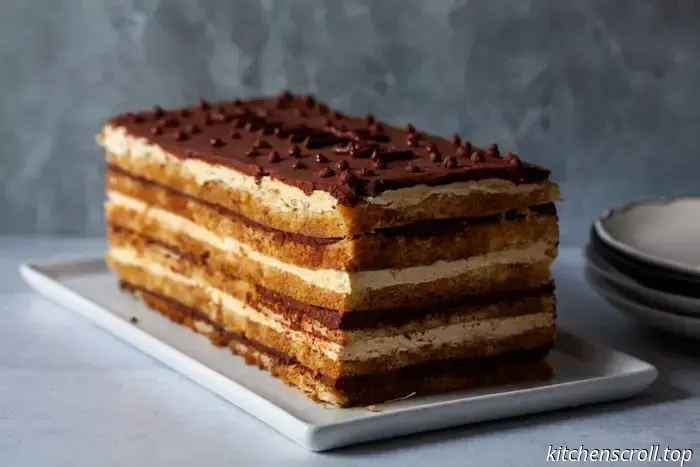
Prepare the cake: Preheat your oven to 350°F (175°C). Line the base of two 9×13-inch pans with parchment paper and apply nonstick spray to both the parchment and the exposed sides of the pans (this extra step is very useful).
In a mixing bowl equipped with a whisk attachment, beat the 4 egg whites on medium speed until they start to thicken — they should appear white and foamy with visible streaks from the whisk. While the mixer is running, add salt and then 1 1/2 tablespoons (20 grams) of sugar. Increase the speed and continue beating the egg whites until stiff, glossy peaks form, which will take about another 2 minutes. Transfer the whipped egg whites to a separate bowl and place the empty mixing bowl back on the electric mixer (there’s no need to clean it).
Add the 4 whole eggs along with the remaining 3/4 cup (150 grams) of sugar to the empty bowl and whip on high speed until the mixture becomes light in color and thickens, forming ripples as the whisk moves through, approximately 8 to 10 minutes. If in doubt, feel free to beat it for an additional minute. Remove the bowl from the mixer and gently fold in the flour using a flexible spatula, followed by the almond flour, adding it in two parts. Finally, carefully fold in the whipped egg whites, ensuring not to deflate the batter.
Pour the batter evenly into the two prepared pans and smooth out the surface using an offset spatula. Bake the cakes until set, which should take around 9 to 13 minutes. Transfer the cakes to cooling racks and allow them to cool completely in the pans. However, I like to carefully run a thin knife around the edges before they cool fully to prevent sticking, even if they were greased well.
Prepare the buttercream: In a medium saucepan, mix 1/2 cup of water with 3/4 cup of sugar, then turn the heat to high and bring it to a boil, cooking without stirring until the mixture reaches 238°F (114°C) (the soft ball candy stage). Remove from the heat.
In a mixing bowl with a whisk attachment, beat the egg yolks on medium-high speed for 2 minutes to loosen them. With the mixer on, slowly drizzle the hot sugar syrup into the yolks (aiming for the center of the bowl as syrup on the sides will harden), and beat until combined. Mix in the espresso and continue to beat until fully combined. Allow the mixture to cool to room temperature. To expedite this process, you can place ice packs around the mixing bowl and run the mixer on low to cool it evenly.
Once cooled, with the mixer running, add the softened butter a piece at a time. It may initially appear curdled, which is normal. After all the butter is added, include the salt and beat on high speed until the mixture transforms into a thick, creamy, silky buttercream that surpasses all other frostings.
Congratulations, you’ve successfully completed the two most challenging parts of the cake! The next steps will be much simpler.
Prepare the chocolate layer: Place the chopped chocolate in a medium bowl. Heat the cream until it simmers, then pour it over the chocolate. Wait a minute, then whisk until the chocolate melts. You can speed up the cooling and thickening by placing the bowl over a larger bowl filled with ice water and whisking until the mixture is nearly thick enough to spread. Remove the bowl from the ice water. It’s fine to stop just before it’s fully thickened, as it will continue to set as it cools.
Prepare the syrup: Mix the sugar with hot espresso, stirring until the sugar dissolves. Add the brandy and set aside.
Assemble the cake: Use a knife (once again) to ensure the cooled cakes aren’t stuck, and carefully lift the first cake, along with the parchment, onto a cutting board. Use a ruler to evenly portion the cake layer into thirds, cutting through the parchment. Repeat this process with the second cake layer, resulting in 6 rectangles of cake measuring approximately 9 inches by 4 1/3 inches.
Take the first cake layer and briefly flip it onto the cutting board to remove the parchment from the back. Position the first layer on your serving plate. Don’t be concerned if the cake is sticky but flexible; it shouldn't break, but even if it did, no one would notice once it's reassembled on the plate.
Generously brush with 1/6 of the soaking syrup, estimating the amount. Spread 1/4 of the chocolate mixture over it. Place the second cake layer on top, with the parchment removed as before. Brush it with another 1/6 of the soaking syrup, then spread 1/3 of the buttercream mixture on it. You’ve now completed the first third of
A layered, striped, and, in my opinion, rather stylish dessert featuring thin layers of almond cake that are soaked in espresso syrup, paired with chocolate ganache and an incredibly tasty espresso buttercream.